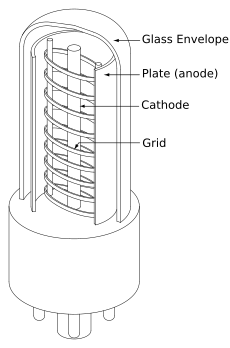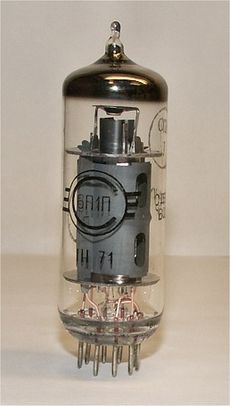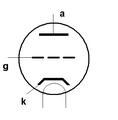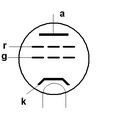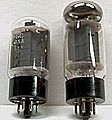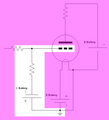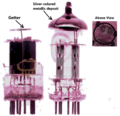Vacuum tube facts for kids
A vacuum tube is an electronic device. People in Britain sometimes call it a valve. These tubes were used in many older radios, TVs, and sound systems. They help control how electricity flows.
Inside a vacuum tube, there's a part called a cathode. It gets heated up, much like the filament in a light bulb. When it gets hot, it shoots out tiny particles called electrons. This process is known as thermionic emission. Another part, called the anode, collects these electrons.
Vacuum tubes need to be hot to work properly. Most of them are made of glass. This makes them easy to break. Early computers, like the ENIAC, used many vacuum tubes. These computers were very big and needed a lot of care to keep running.
How Vacuum Tubes Started
The idea for vacuum tubes came from a discovery by Thomas Edison. He found that electricity could move through gas or empty spaces, not just solid materials. This was called the "Edison effect." Without this important discovery, vacuum tubes would not exist.
The first vacuum tube was invented in 1904 by John Ambrose Fleming. It was a simple type called a diode. Later, in 1906, Lee De Forest invented the "audion." This was improved in 1908 and became known as the triode. Triodes were first used in telephone systems to make sounds louder. Many other kinds of tubes were invented for different uses.
In the 1960s, a new device called the transistor came along. Transistors were much smaller and cheaper than vacuum tubes. They also used less power and worked with lower electricity. Plus, transistors were very strong and lasted a long time. They didn't break easily if dropped. Because of these reasons, most radios, TVs, and sound systems started using transistors instead. However, some powerful electronics, like broadcasting transmitters, still used tubes for a while. Televisions kept using a special type of vacuum tube called a cathode ray tube until the early 2000s.
Where Vacuum Tubes Are Used Today

Today, vacuum tubes are not common in everyday electronics. Most devices now use transistors. However, vacuum tubes are still used in some special equipment:
- Systems that need very high power or very strong signals. This includes television broadcasting, X-ray machines, radar, and microwave ovens.
- Some people who love music buy special sound systems. These systems use vacuum tubes to make the music sound a certain way. This is called tube sound.
- Musicians who play electric instruments, like electric guitars, often use amplifiers with vacuum tubes. They like the unique sound these tubes create.
- Vacuum fluorescent displays are thin tubes that show simple information, like numbers. You might still see them on older audio equipment or home appliances. However, newer LED displays are replacing them.
- Some very specific tools, like photomultiplier tubes, also still use vacuum tubes.
Images for kids
-
The first triode, the De Forest Audion, invented in 1906
-
General Electric Company Pliotron, Science History Institute
-
Vacuum tubes seen on end in recreation of World War II-era Colossus computer at Bletchley Park, England
-
Typical VFD used in a videocassette recorder
See also
 In Spanish: Válvula termoiónica para niños
In Spanish: Válvula termoiónica para niños


